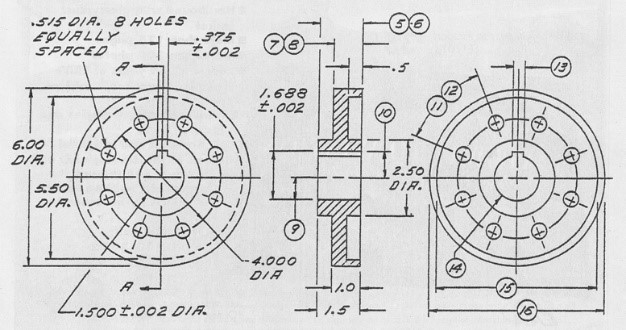

BLUEPRINT READING HOW TO
How to Read Blueprints 75. The print is what shows the builders, the electricians, the framers all of the trades people exactly what needs done on any construction project. The primary audience is production and inspection personnel, supervisors, group leaders, set-up personnel, and anyone who wishes to read engineering drawings. Blueprints provide the vital information required by all the parties involved in the building process. A blueprint is the fundamental plan for the construction of any structure. The layout is a lot like shop plans you have probably seen before. These training programs are based on ANSI standards and incorporate input from a broad industrial cross-section. According to the article Welding Symbols, there are typically six parts in a welding blueprint: The revision blocks. Special kinds of blueprints, including foundation blueprints, framing blueprints and system blueprints, which can all contain specific notations and meanings.The six programs in our online blueprint reading training course develop workers’ abilities to accurately locate and interpret dimensions on engineering drawings.Pricing and estimates, and specifically how to use blueprints to figure out materials costs, labor time and other project details before you begin.Measuring tools and sketching, so you can understand exactly what an architect or engineer is trying to convey to builders on a blueprint.Understanding drawings and specs, with an emphasis on the meanings behind different lines, symbols and abbreviations that are typically found on blueprints.32-hour seminar covering the fundamentals of blueprints, including common features on residential and light industrial construction projects.Here are just a few of the things you’ll learn:
BLUEPRINT READING PROFESSIONAL
As part of our course, you’ll learn everything you need to know to read residential and light commercial blueprints, as well as receiving high-level instruction from experienced professionals and informative learning materials.Īs with every CSLS course, our blueprint program is designed to help you become a licensed contractor, but also to succeed as a professional in today’s competitive construction market. There are a number of reasons why students may not have had previous experience reading and analyzing blueprints as part of a construction project, but this basic skill is necessary not only to become a California state licensed contractor, but also to bid on and complete most jobs.
BLUEPRINT READING SERIES
To help you prepare for the types of situations you’ll face in the real world as a licensed contractor, CSLS offers a series of ongoing blueprint reading courses, designed to turn you from a novice to a professional in no time. And in order to properly estimate project costs, you have to be able to examine them closely and figure out what sorts of materials, labor and time will be needed to turn the blueprints into a finished product. In order to be hired as a licensed contractor for major construction projects, it’s important that you are able to read blueprints and use them without misunderstandings. Introduction to Blueprint Reading (AVAILABLE ONLINE) A skill every contractor and construction professional needs to get ahead.

C47 – General Manufactured Housing Contractor.C35 – Lathing and Plastering Contractor.C33 – Painting and Decorating Contractor.C32 – Parking and Highway Improvement Contractor.C31 – Construction Zone Traffic Control Contractor.C28 – Lock and Security Equipment Contractor.C21 – Building Moving/Demolition Contractor Unit 1 covers the introduction and about the drawings I have my student do before introducing blueprint reading.C20 – Warm-Air Heating, Ventilating and Air-Conditioning Contractor.C15 – Flooring and Floor Covering Contractors.C6 – Cabinet, Millwork and Finish Carpentry Contractor.C5 – Framing and Rough Carpentry Contractor.C4 – Boiler, Hot Water Heating and Steam Fitting Contractor This course provides students with basic instruction on blueprint reading to enable them to understand various types of blueprints, shop prints and.C2 – Insulation and Acoustical Contractor.B2 - Residential Remodeling & Home Improvement.Class “B2” - Residential Remodeling & Improvement.

Class “B” - General Building Contractor This program is designed to help workers develop the basic skills required for visualizing and interpreting industrial prints, skills which.Class “A” - General Engineering Contractor.


 0 kommentar(er)
0 kommentar(er)
